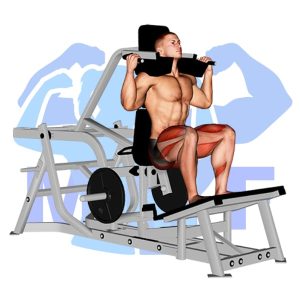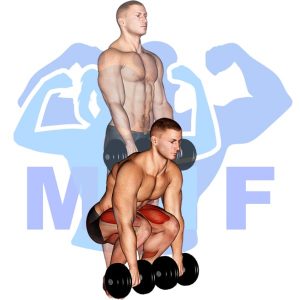If you’re struggling to build lower body strength, you’re not alone. Traditional squats and lunges can become monotonous, and sometimes it feels like you’ve maxed out your progress. That’s where the barbell zercher squat comes in – this unique variation effectively targets your quadriceps, glutes, and core all at once. Many people shy away from the barbell zercher squat due to the uncomfortable arm position, but fear not! In this post, we’ll provide tips and tricks to help you confidently incorporate this powerful exercise into your routine, and unlock the gains you’ve been searching for.
Barbell Zercher Squat Summary
- Primary Muscles: Quadriceps
- Secondary Muscles: Adductor Magnus, Gluteus Maximus, and Soleus
- Equipment: Barbell
- Mechanics Type: Compound
- Force: Push
- Utility: Basic

Barbell Zercher Squat Instructions
- The barbell Zercher squat is a front squat with an unusual grip. Instead of gripping the bar with your hands, you will rest the bar in your elbow joints.
- Start with the bar in a rack that is position low enough that you will be able to un-rack it when it is set in your arms.
- Curl your arms around the barbel and place the barbell in your elbows joint.
- Lift the barbell off the rack and set out for your squats.
- Squat down maintaining the barbell moving in a straight line. For Zercher Squats you will have to move your hips back further than you do for either the front or regular squats to keep the weight over your feet.
- After you reach the bottom press with your legs and pull your hips forward maintaining the barbell moving straight up.
- After you get to the top, repeat the Zercher squats until your set is complete.
Video Tutorial
Barbell Zercher Squat Muscles
Target (Agonist)
Synergists
- Adductor Magnus
- Gluteus Maximus
- Soleus
Dynamic Stabilizers
Stabilizers
- Biceps Brachii
- Brachialis
- Brachioradialis
- Deltoid, Anterior
- Deltoid, Lateral
- Erector Spinae
- Levator Scapulae
- Pectoralis Major, Clavicular
- Pectoralis Major, Sternal
- Serratus Anterior
- Supraspinatus
- Trapezius, Lower
- Trapezius, Middle
- Trapezius, Upper
Antagonist Stabilizers

Benefits of Barbell Zercher Squat
The Barbell Zercher Squat is an excellent exercise for building strength in the quadriceps. This exercise increases the stability and coordination of the core muscles while targeting the quadriceps. It also increases the overall range of motion, allowing for greater muscular development. The squat also strengthens the glutes and hamstrings, as well as the abdominal muscles. Furthermore, the Barbell Zercher Squat is a great exercise for improving balance, coordination and stability. It can also help improve posture and overall flexibility. All these benefits make it an excellent exercise for anyone looking to strengthen their quadriceps and build a stronger and more balanced physique.
Tips for Performing Barbell Zercher Squat
Following these tips can help you get the most out of your barbell zercher squat. With practice and dedication, you can add this exercise to your workout routine to increase strength, stability, and power.
- View Your Form by Make Use Of A Mirror. You could believe a little vain looking in a mirror whenever you are exercising, but you are not adoring yourself, you are making sure your technique is strong.
- Utilize A Cage With Carefully Placed Safety Bars. Using good safety you will drive yourself farther and your pump will go up.
- Vary Your Training Sets Randomly With Varied Weight And Repetition Mixtures. For example sets of 5 of 5 for a week or two, then 3 sets of 8-20 reps for a few weeks.
- Perform your large compound movements first of your work out, after that perform isolation lifts to focus on individual muscles towards the end. You really want the optimum capabilities of your individual muscle groups any time you accomplish compound exercises like squats, bench, and deadlifts. Next, you want to focus on the areas that you identified were weak during those exercises, or areas that couldn’t get fatigued as a result of the type of compound lift you conducted.
Benefits and Tips Video
Frequent Mistakes To Avoid
While the Barbell Zercher Squat can be an effective exercise for building strength and size, it is important to be aware of common mistakes that can lead to injury or poor form. To maximize your gains and minimize your risk of injury, it is important to be mindful of the following mistakes while performing the Barbell Zercher Squat.
- You Can’t Miss Your Warm-Up. Warming your Muscle tissue is the Best way to avoid personal injury.
- Don’t Do The Same Exercises Each And Every Time. When you do the exact same exercise every work out ones muscular tissues will be trained to undertake that individual lift well, but you will plateau a lot quicker.
- You’ll Do Better To Not Make It To Easy. Your main way to get stronger will be to challenge yourself.
Find More Barbell Exercises Here
Variations and Complementary Exercises
If you are looking for variations, complementary, or alternative exercises to the Barbell Zercher Squat, there are several options to choose from. The following exercises all work similar muscles as the Barbell Zercher Squat and can be used as a substitute in your workout routine.
Bulgarian Half Squat With Band

The Bulgarian Half Squat with Band is a great complementary or alternative exercise to the Barbell Zercher Squat. This exercise targets the same muscles as the Barbell Zercher Squat, while allowing for additional stability and support. It focuses on strengthening the quads, hamstrings, glutes, and core. To perform this exercise, you will need a band, preferably one with handles. Place the band around your shoulders and step forward with one leg. Keep your back straight, chest up, and core engaged as you lower into a half squat. Drive through your heel to return to the starting position. This exercise will help you to build strength, balance, and stability in the lower body.
Dumbbell Half Squat

The Dumbbell Half Squat is an excellent complementary or alternative exercise to the Barbell Zercher Squat. It requires less weight and increases stability and balance, as it requires you to lift the weights on your own, rather than relying on a barbell. This exercise also targets the glutes and legs more than the Barbell Zercher Squat, as it requires the legs to be in a greater range of motion. It is an excellent way to mix up your workout routine and challenge your muscles in different ways.
Dumbbell Squat

The Dumbbell Squat is a great complementary or alternative exercise to the Barbell Zercher Squat. This exercise works the same muscles as the Zercher Squat, but in a different way. While the Zercher Squat focuses on lower body and core strength, the Dumbbell Squat works more on balance and coordination. It also engages the upper body more than the Zercher Squat, as it requires you to hold the dumbbells in front of your chest. This exercise can be done with a range of weights and is suitable for all levels. The Dumbbell Squat is an effective way to build lower body strength and can be used to supplement or replace the Zercher Squat for those looking for variety in their workouts.
Check Out These Top Barbell Exercises
Lever Full Squat (Machine)

The Lever Full Squat (Machine) is a great complement or alternative to the Barbell Zercher Squat. It isolates the legs, allowing you to focus on your form and technique, while also reducing the risk of injury. The machine also allows you to adjust the amount of weight lifted and the height of the foot pads, making it easier to tailor your workout to your needs. Furthermore, the lever full squat can provide an intense workout without the need for a spotter. As an alternative to the barbell zercher squat, this machine can be a great way to mix up your leg day routine.
Lever Squat (Machine)

The Lever Squat (Machine) is a great alternative or complementary exercise to the Barbell Zercher Squat. This machine utilizes a lever arm to help you safely perform squats with heavier weight than you could manage on your own. This exercise helps you develop balance, strength, and stability. It also works the same muscles as the Barbell Zercher Squat—namely the quadriceps, hamstrings, glutes, and core. The Lever Squat Machine allows you to control the speed of the movement, making it easier to focus on proper form and technique while reducing the risk of injury.
Prisoner Squat

Prisoner Squat is a great alternative or complementary exercise for the Barbell Zercher Squat. It is an easier, lower-impact squat variation that puts less strain on the lower back and shoulders. The prisoner squat is done by standing with feet shoulder-width apart and arms placed behind the head. The squat is then performed by bending the knees and hips while keeping the chest up and back straight. This variation of the squat is great for those who are looking to improve their squat technique and form without the added difficulty of using a barbell. It also works well as an accessory exercise to supplement heavier barbell squats.
Find More Legs Exercises Here
Opposing Complementary Exercises
In order to make sure that you have a well-rounded workout, it is important to supplement the Barbell Zercher Squat with exercises that target the opposing muscle groups. This will help ensure that your muscles are worked from all angles, which can help you build strength and prevent injury. Below are some exercises that target the opposing muscle groups of the Barbell Zercher Squat.
Barbell Sumo Deadlift

The Barbell Sumo Deadlift is the perfect complement to the Barbell Zercher Squat. While the Zercher Squat works the quadriceps and glutes, the Sumo Deadlift works the hamstrings and hips, which are its opposing muscle group. This exercise is ideal for strengthening the posterior chain and helps to create a balanced physique. Both of these exercises also help to develop core strength and stability, as well as overall power. Together, they make a great combination for improving overall physical fitness.
Dumbbell Deadlift

The Dumbbell Deadlift is a great exercise to complement the Barbell Zercher Squat, as it works the opposing muscle group. This exercise works the posterior chain, specifically the hamstrings, glutes, and lower back, while the Barbell Zercher Squat works the quads and core. The Dumbbell Deadlift is a great way to build strength and balance in the posterior chain, which will help with overall stability and strength when performing the Barbell Zercher Squat. Additionally, it helps to develop the mobility of the hip joints and increase flexibility in the lower back.
Dumbbell Single Leg Deadlift

The Dumbbell Single Leg Deadlift is a great complement to the Barbell Zercher Squat. This exercise targets the opposite muscle group to the Barbell Zercher Squat by targeting the hamstrings and glutes on one side of the body at a time. This exercise will help to improve stability and balance, as well as promote overall strength and power in the lower body. Additionally, this exercise can help to increase flexibility in the hip flexors, which can help improve performance in the Barbell Zercher Squat.
Take Your Squats Up A Level With The Barbell Zercher Squat!
If you’re looking for a new way to challenge your squat routine, the barbell zercher squat is worth giving a try. This variation places the barbell in the crooks of your elbows, challenging your core and upper body as well as your lower body. Not only does it target your quads, glutes, and hamstrings, but it’s also a great way to improve your posture and grip strength. Don’t be intimidated by the unconventional set-up, take your squats up a level with the barbell zercher squat and see the benefits for yourself!
References: Wikipedia | ExRx.net | PubMed.gov | Comprehensive List of Legs Barbell Exercises




